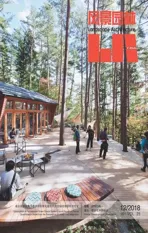刊首语
2018-04-17
浅山区的城市化

“浅山区”并非是严格意义上的一种地理单元或地貌类型,它是对位于深山与平原过渡地带上的山地区域的一种宽泛性称谓,可包括低山、丘陵、台地和冲沟等多种地形特征。
二次世界大战后,欧美发达国家和一些新兴发展中国家进入快速城市化进程,人口聚集导致适宜建设的平地资源日益短缺,越来越多的浅山地带被转化为城市建设用地,成为都市化进程中的市民居住或休闲的空间。
中国在快速城市化过程中,浅山地带也受到越来越多的关注。最近我看到一则房地产广告,说纵观全球,凡浅山地带都拥有绝佳的居住环境,这里往往是房价最高的区域,对这一点我深信不疑。中国是一个山地国家,许多城市位于山前平原或山间盆地,如果交通方便,出城市不远就到了背依群山、面朝田园和城市、风景优美的浅山地带,受各种利益的驱动,城市发展必然会逐步深入到浅山区。实际上在世界各地的快速城市化过程中,人类的各种大规模建造都曾经或已经开始向城市周边的浅山区扩张和蔓延。
过去30年来中国的城市化率平均每年增长约1%左右,在未来的一段时间内仍将保持相近的增长率,而城市化率每增加1个百分点,中国至少要有2 000km2的各类土地转变为城市建设用地,这其中就包括浅山区。
然而,浅山区的开发建设却引起我深深的忧虑,因为其一,浅山是山地生态系统与平原生态系统相互交错的区域,是山岳与平原之间重要的生态缓冲区,也是山前平原最重要的水源涵养地和地下水回补区,管理好浅山地带的生态环境对于维护整个城市健康的生态系统至关重要。大规模的城市建设蔓延到浅山区,如果没有深入的研究、合理的规划、恰当的建设,极有可能威胁到这一极为敏感地带的生态环境,打破固有的深山——浅山——平原相互关联的生态系统,进而引起城市生态环境的恶化,甚至引发一些地质灾害。
另外,浅山区由于方便到达,自古以来就是山地中承受开发建设压力最大的区域,历史上的人类活动在此留下了丰富的文化遗产。风景优美、临近城市的浅山区往往拥有多样的人文风景资源,如山村聚落、寺庙、园林、书院、摩崖与石刻,等等。人文风景荟萃的浅山地带都是城市重要的风景地和观光休闲地,如果大规模的城市建设侵入这里,处理不当,必然会带来风景资源的破坏。
中国历史上有大量山水画描绘着中国人在浅山地带的建造实践,画面上的山、水、聚落、田园都完美地融合在一起,形成独特而恬静的山水风景。当然,古代的建造技术较为简单,山村聚落规模不大,人们对自然的干预能力也有限,建造行为总是顺应自然环境而为。那么今天,以现代工程技术为支撑,在浅山地带建造规模庞大的城市新区,我们又如何能够像古人一样,实现人工建造与自然山水之间的和谐,建设具有诗意的家园?
本期的专题为“浅山·都市化中的保护”,收录的论文分别从不同的角度探究了城市发展与浅山生态环境之间的复杂动态关系,包括政治、经济和文化过程对于浅山景观变化的影响,浅山景观变迁的模式和机制,世界主要都市区的山地开发管控模式等,希冀能充实和丰富对浅山区的生态保护及规划建设的研究。

主编:王向荣教授
2018年12月10日
PREFACE
Urbanization of Low Mountain Area
“Low mountain area” as neither geographical unit nor geomorphological type in strict sense, refers basically to the transitional area from high mountains to plains so inclusive of the terrains of low elevation mountains, hills, terraced tablelands and eroded gullies etc.
With rapid urbanization and population concentration of the developed countries of Europe, the United States and the emerging market countries after the Second World War, there have been increasing shortage of suitable flat land resources for construction.Consequently, more and more low mountain areas were converted into urban construction lands as residential or recreation spaces for citizens.
Low mountain areas are attracting growing attention in course of the rapid urbanization of China. I recently noticed a real estate ad declaring that the low mountain areas of the world all have magnificent residential conditions so real estate prices are often of the highest, and I would approve it. As a mountainous country, China has many cities located at piedmont plains or mountainous basins.With improved traffic condition, one need not travel far from from the city to reach the low mountain areas with beautiful scenery of farmlands and views of mountain and also urban landscape. Driven by various interests, urban development will inevitably extend into low mountain areas. In fact, in the rapid urbanization process around the world, some large-scale constructions have already spread to the low mountain areas around the city.
The urbanization rate of China grew by about 1% annually over the past 30 years and would be predicted to continue growing at a similar rate in the near future. That is to say, with one percentage point of urbanization, a land area about 2,000 square kilometers of non-construction land in China shall be converted into construction land. Such non-construction land include low mountain areas.
Nevertheless, I am deeply concerned about the development construction of the low mountain areas. Firstly, the low mountain areas as intersects of mountain ecosystems and plains are important ecological buffer zones between mountains and plains. They are also the most important water conservation area and groundwater recharge area of the piedmont plains. To these ends, appropriate management of the ecological condition of the low mountain areas is crucial for maintaining the health of the ecosystem of the entire city. With large-scale urban construction spread to low mountain areas without in-depth feasibility study, rational planning and proper construction, the ecological condition of the much sensitive areas would be threatened by the broken inherent ecological linkage among sequence of high-elevation mountain——low-elevation mountain——plains, resulting in deterioration of urban environment even geological disasters.
In addition, due to the easy access of low mountain areas, it have been the areas under the greatest development construction pressure since ancient times, therefore containing abundant historical cultural heritages of humans. The low mountain areas with beautiful scenery, easier traffic to neighboring cities often have abundant cultural and scenic resources, such as rural settlements,temples, gardens, academies, cliff or stone carvings, etc., which are popular for sightseeing, leisure, recreation of the city. Large-scale urban construction invasion into low mountain areas will inevitably jeopardize such cultural or scenic resources.
Chinese history has also witnessed numerous landscape paintings depicting the local people’s construction practices in low mountain areas. In these paintings, the mountains and hills,water network, settlements and farmlands integrate to form unique peaceful landscape. Due to the relatively simple construction technology, the scale of settlement on mountainous is restricted thus the intervention to the nature is limited, so that we can find that the ancient construction behavior are always conformed to its natural environment. Then, with the support of modern facilities and engineering technology, how can we achieve the harmony between artificial construction and natural landscape to build poetic homelands in a similar way of our ancestors when facing the largescale development of low mountain areas?
The theme of this issue is “Hillside: Preservation in Urbanization”. The adopted essays explored the complex dynamic relationship between urban development and ecological condition of low mountain areas from different perspectives, covering the impact of political, economic and cultural processes on landscape change of low mountain areas, the pattern and mechanism of landscape change of low mountain areas, the mountainous development governance model of major metropolitans of the world etc. which I think will enrich the research context on the ecological conservation, planning and construction in the low mountain areas.
